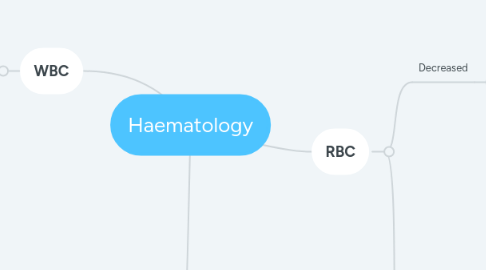
1. WBC
1.1. Increased
1.1.1. Neutrophilia
1.1.1.1. Reactive
1.1.1.1.1. Bacterial infection
1.1.1.1.2. Autoimmune
1.1.1.1.3. Tissue necrosis
1.1.1.2. Malignant
1.1.1.2.1. CML
1.1.2. Eosinophilia
1.1.2.1. Reactive
1.1.2.1.1. Parasite infection
1.1.2.1.2. Allergic
1.1.2.2. Malignant
1.1.2.2.1. Hodgkin
1.1.2.2.2. Non-Hodgkin T Cell
1.1.2.2.3. CML
1.1.2.2.4. Chronic eosinophilic leukemia
1.1.3. Basophilia
1.1.3.1. Reactive
1.1.3.1.1. Pox virus
1.1.3.2. Malignant
1.1.3.2.1. CML
1.1.4. Monocytosis
1.1.4.1. Reactive
1.1.4.1.1. TB
1.1.4.1.2. Brucella
1.1.4.2. Malignant
1.1.4.2.1. CML
1.1.5. Lymphocytosis
1.1.5.1. Reactive
1.1.5.1.1. Infectious
1.1.5.1.2. Inflammation
1.1.5.2. Malignant
1.1.5.2.1. CLL
1.1.5.2.2. NHL
2. Clotting disorders
2.1. Thrombophilia (platelet problem)
2.1.1. Autoimmune thrombocytopenic purpura
2.2. Coagulopathy (clotting factor problem)
2.2.1. Haemophilia A (Factor VIII)
2.2.2. Haemophilia B (Factor IX)
2.2.3. Haemophilia C (Factor Xi)
2.2.4. Von Willebrandt disease (VWF)
3. RBC
3.1. Decreased
3.1.1. IDA
3.1.1.1. due to blood loss
3.1.2. Leucoerythroblastic anaemia
3.1.2.1. due to BM infiltration
3.1.2.1.1. Cancer
3.1.2.1.2. Myelofibrosis
3.1.2.1.3. Infection
3.1.3. Haemolytic anaemia
3.1.3.1. Acquired
3.1.3.1.1. Immune-mediated
3.1.3.1.2. Non immune-mediated
3.1.3.2. Hereditary
3.1.3.2.1. Membrane
3.1.3.2.2. Enzyme
3.1.3.2.3. Haemoglobin
3.2. Increased
3.2.1. Polycythemia
3.2.1.1. Relative
3.2.1.2. True
3.2.1.2.1. Primary
3.2.1.2.2. Secondary

